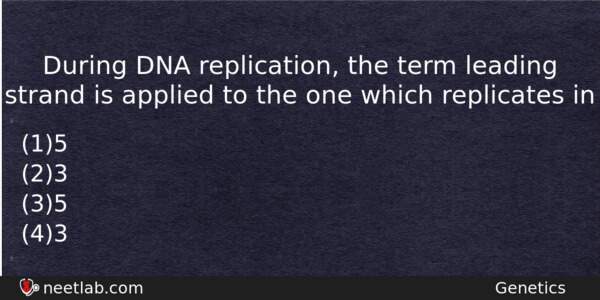| ⇦ | 
| ⇨ |
During DNA replication, the term leading strand is applied to the one which replicates in
Options
(a) 5′ → 3′ direction discontinuously
(b) 3′ → 5′ direction continuously
(c) 5′ → 3′ direction continuously
(d) 3′ → 5′ direction discontinuously
Correct Answer:
5′ → 3′ direction continuously
Explanation:
When the double helix of DNA unwinds, DNA replication on one of the two strands (3′ to 5′ strand) can easily proceed continously in 5′ to 3′ direction. This is the leading strand. On the other strand (5′-3′) if the synthesis has to take place in 5′ to 3′ direction, it has to be synthesized in a direction opposite to that on the leading strands. This strand is the lagging strand and on this strand synthesis takes place in segments discontinously and these segments are called Okazagi fragments which then fuse to create an intact lagging strand. This behaviour where the leading strand is synthesized continously and the lagging strand is synthesized discontinously is called semi-discontinous replication.
Related Questions: - Yeast cell can progress through the cell cycle in about
- Cell theory is not applicable for
- The respiratory and cardiac centres are located in
- Homeostasis is
- Number of carboxylation occur in one Calvin Cycle is
Topics: Genetics
(204)
Subject: Biology
(4253)
Important MCQs Based on Medical Entrance Examinations To Improve Your NEET Score
- Yeast cell can progress through the cell cycle in about
- Cell theory is not applicable for
- The respiratory and cardiac centres are located in
- Homeostasis is
- Number of carboxylation occur in one Calvin Cycle is
Topics: Genetics (204)
Subject: Biology (4253)
Important MCQs Based on Medical Entrance Examinations To Improve Your NEET Score
18000+ students are using NEETLab to improve their score. What about you?
Solve Previous Year MCQs, Mock Tests, Topicwise Practice Tests, Identify Weak Topics, Formula Flash cards and much more is available in NEETLab Android App to improve your NEET score.
Share this page with your friends

Leave a Reply